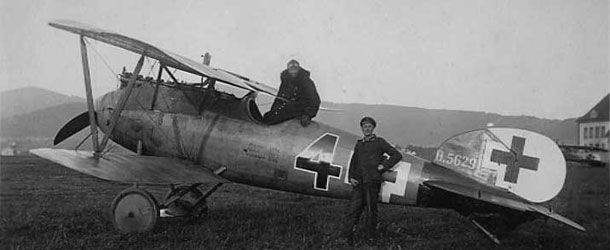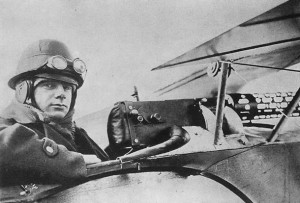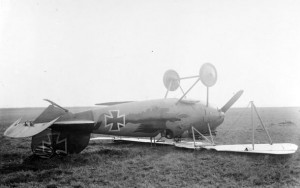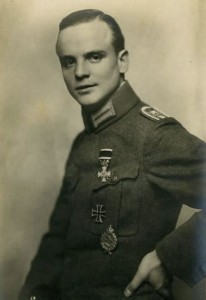In our previous article we presented the Albatros D.Va fighter - now let’s learn something more about the pilots of the three versions of this aircraft featured in the WW1 Wings of Glory Airplane Packs: Ernst Udet, Hans Joachim von Hippel and Josef Carl Peter Jacobs.
Ernst Udet
The youngest and second-highest-scoring German ace of WW1 – with 62 confirmed victories, Oberleutnant Ernst Udet was born in 1896 in Frankfurt am Main. He was fascinated by flying machines since he was a child, when he built and flew model airplanes with his school friends and helped to found the Munich Aero-Club in 1909.
Udet tried to enlist in the German army in August 1914, but he was turned away because he was too short – only 1,52 m. Then he started to serve as a motorcycle messenger. He got his flying license in 1915, after taking private lessons, and in September he entered the German Air Force. Posted to the Flieger Abteilung 206, he was quickly promoted due to his aggressive style and eagerness for battle. Transferred to Flt. Abt. 68 as a staff sergeant, he began to fly the Fokker Eindecker fighter.
In his first one-on-one combat, against a French Caudron, Udet froze and couldn't fire; the French gunner shot off his goggles, cutting his face with glass splinters but nothing worse. Privately shamed by his failure of nerve, Udet redoubled his gunnery practice, working with a mock-up of a Nieuport.
His first victory was scored on March 18th, 1916, when he went up to 2,800 meters with his Fokker to intercept some enemy airplanes headed toward Muelhausen. Alone, he found over twenty French bombers: a large Farman in the middle, flanked by other Farmans and Caudrons. This time, he kept his nerve, closed with the Farman, and opened up at forty meters, setting it on fire. He continued to dive through the formation as other French airplanes went after him. He dived down steeply about 300 meters to escape. This action granted to Udet the award of the Iron Cross, First Class.
In September his unit was reorganized as Jagdstaffel 15, and in January 1917 it was equipped with the new Albatros D.III. From October 1916 to May 1917, at Jasta 15, Udet scored five more victories.
In June 1917, Udet was involved in one of the most famous air duels of World War I. While balloon hunting on a solo patrol, he met a Spad VII flown by Georges Guynemer, and was locked in a duel-to-the-death with the famed French ace. When he had the French pilot in sight, Udet pulled the fire button, but his guns remained silent. They were jammed. Frantically, he pounded them with his fist just as Guynemer flew by overhead. Guynemer closed up again, almost upside down now, but instead of sending a blast of lead into his helpless opponent, he raised a gloved hand, waved and then disappeared to the west. Till the end of his life, Udet never forgot that act of chivalry.
Udet was transferred to Jasta 37 in July 1917, and there he brought his score up to nine victories by the end of August. On November 7th, he was nominated commander of the unit and proved to be a good leader - despite his seemingly frivolous nature, drinking late into the night and womanizing. He spent long hours training novice pilots in the art of air fighting and, like many successful aces, emphasized good marksmanship over flashy stunt flying. By the end of that year, he was a 16-victory ace and a highly decorated pilot. By February 1918, he had 20 victories scored.
His success had attracted the attention of Manfred von Richthofen, always on the lookout for bright and aggressive pilots, and he asked Udet if he would like to join his Jagdgeschwader I (JG.I), the “Flying Circus”. He immediately accepted and took the command of Jasta 11, which was equipped with the highly maneuverable, rapid-climbing Fokker Dr.I triplane. Udet began flying multiple patrols daily, although he was increasingly troubled by an intense pain in his ears, and pushed his victory score up to 23, before the pain became so intolerable that Richthofen ordered him to take sick leave, in April 1918.
That month, Udet received news that he had been awarded one of Germany's highest military honors, the Ordre Pour le Mérite - the 'Blue Max'. But the award was marred by the news that Richthofen had been lost in combat on April 21. Udet returned to the front on May 20, taking command of Jasta 4 of JG.I. At Jasta 4, where he usually flew a Fokker D.VII with his girlfriend's name, "Lo", painted on the fuselage, Uded scored 38 more victories from May 31st to September 26th 1918, when he was wounded in the thigh. He was still recovering from this wound on Armistice Day, November 11, 1918. After the end of the WW1, Ernst Udet struggled to make a living in the early 1920's. He built airplanes for a while, and raced, traveling to the United States and Argentina for air shows. He also contributed to filming movies in exotic locations, traveling to Africa and the Arctic, piloting camera-equipped airplanes.
When Hitler re-armed Germany in the Thirties, Udet ignored politics and despised the Nazi party's brutality, intolerance and authoritarianism, but he was proud to be a German and was proud of his war service. He joined the Nazi party in 1933, and in 1934, he entered the new Luftwaffe and was promoted rapidly from Oberstleutnant to Oberst (colonel) and then inspector of fighter and dive-bomber pilots.
In the summer of 1936 Udet was persuaded by Göring to become the head of the technical office of the Reich's air ministry, a position with high organizational responsibilities. On the eve of World War II, Udet was promoted again, this time to Generalluftzeugmeister, or chief of armaments procurement. When the war started, the weight of his office was heavy upon him. In July 1940, he was awarded the Knight's Cross of the Iron Cross and promoted to Generaloberst.
But the new position brought more responsibilities and troubles. When the Luftwaffe failed to overwhelm the Royal Air Force during the Battle of Britain, Udet's office was blamed. The invasion of Russia in June 1941 only added to the pressure on him, and he felt increasingly trapped in his job. At the end of August, Udet had a long, private talk with Göring in which he tried to resign. Göring refused, knowing that such a resignation from a top Luftwaffe official would create bad publicity. On November 17th, 1941, Udet put a pistol to his head and pulled the trigger. According to Nazi propaganda, the pilot had died heroically while testing a new aircraft.
Hans Joachim von Hippel
The beautiful Albatros D.Va with a red dragon depicted on the fuselage featured as one of the new Wings of Glory Airplane Pack was flon by Lieutenant Hans Joachim von Hippel, credited with two victories during World War I, when he was in service at Jasta 5. This aircraft was previously flown by Oberleutnant Richard Flashar, commander of Jasta 5, and it was handed down to von Hippel when Flashar received a new D.V.
Hans von Hippel was born near Berlin in September 1893. At the beginning of WWI, he served in a field artillery regiment. In May 1915, he was promoted to Lieutenant, and in 1916 he asked to be transferred to the air force. After he successfully completed the flight training, Hippel was assigned to FA 37 in early 1917.
On October 30th 1917 he shot down a Nieuport 17, together with his observer, in his first confirmed victory. In December that year, von Hippel was posted to the Jasta 5, commanded by Oblt. Richard Flashar. The unit at that time used Albatross D.V. fighters. He scored his second victory in January 1918, shooting down a Sopwith Camel.
On February 18th 1918, von Hippel was flying the Flashar's Dragon Albatros in combat when, after a dive, he lost the left lower wing at an altitude of 4000 meters, but he was able to land the damaged aircraft, and escaped unharmed. Von Hippel served with Jasta 5 until August 1918, and then was transferred to Jasta 71.
After the war, von Hippel was doing spectacular aerial aerobatics – among other ventures, he flew under the Hohenzollern bridge in Cologne in 1926. From 1927 to 1935 he was a Lufthansa employee. In 1936, he joined Luftwaffe, and served as transport pilot with the Junkers Ju 52, reaching the rank of Lieutenant Colonel. He died in 1975, aged 82.
Josef Carl Peter Jacobs
With 48 victories scored, Leutnant Josef Karl Peter Jacobs was one of the leading German air aces of the First World War. He was known for flying black painted aircrafts – as the Albatros D.Va presented as one of the Wings of Glory Airplane Packs.
Born in May 1894 in the Rhineland, he entered fight school in 1912. When WW1 started, he promptly enlisted in the Germany Army's air service.
Jacobs was posted to FEA9 for training as a military pilot, and served for a year as long-range reconnaissance pilot over the Allied lines. In 1916 he was transferred to Fokker Staffel West flying Fokker E.IIIs. In February that year, he downed a French Caudron, but this victory remained unconfirmed for lack of an independent witness. He finally achieved his first official victory on May 12th, when he shot down a two-seater Caudron crewed only by its pilot.
Fokker Staffel West became Jasta 12 in October 1916, and Jacobs remained with it, although a month later he was transferred to Jasta 22, at that time under the command of Oberleutnant Erich Hönemanns, who was his friend. There he was initially employed as an instructor, until January 1917. In June that year he assumed command of Jasta 7. After reaching a score of 24 victories, Jacobs was awarded the prestigious "Pour le Merite". His total tally for the war eventually reached 48 aircraft and balloons.
After the armistice, Jacobs continued to serve in the Baltic, fighting against the Bolshevik forces, with Kommando Sachsenberg, and then he briefly became a flying instructor in the Turkish Army, before completely withdrawing from military activity. Jacobs refused to join the Luftwaffe after being asked by Hermann Göring, and during World War II he moved his aircraft manufacturing company to the Netherlands and at one stage he was forced into hiding, after refusing to let Göring become a major shareholder in his company.
Jacobs died in Munich, Bavaria, Germany in 1978.
Information sources: The Aerodrome, Wikipedia, HistoryNet.com, Ace Pilots, First World War.












Follow Us on